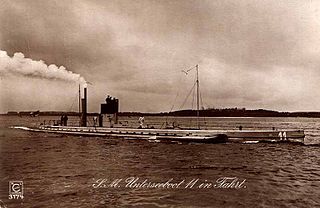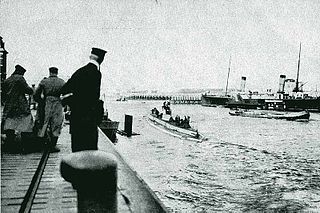SM U-2 was a German U-boat built for the Imperial German Navy. Only one of the type, sometimes called German Type U 2 submarine, was built. U-2 was ordered from Kaiserliche Werft of Danzig on 4 March 1906, launched on 18 June 1908, and commissioned into the Imperial German Navy on 18 July 1908. She conducted no war patrols and spent World War I as a training platform.

SM U-5 was a German Type U 5 U-boat built for the Imperial German Navy. She was commissioned 2 July 1910 in Germaniawerft in Kiel. She served in World War I under the command of Kptlt. Johannes Lemmer, with no recorded sinkings of enemy ships on two patrols. She was lost in an accident off the Belgian coast on 18 December 1914, and sank with no survivors - all of her 29 crew members died.

Type UC II minelaying submarines were used by the Imperial German Navy during World War I. They displaced 417 tons, carried guns, 7 torpedoes and up to 18 mines. The ships were double-hulled with improved range and seakeeping compared to the UC I type.
SM U-137 was a Type U 127 U-boat of the Imperial German Navy during World War I. Her construction was ordered on 27 May 1916 and her keel was laid down by Kaiserliche Werft Danzig. She was launched on 16 December 1916 and she was commissioned on 8 January 1918. She made no war patrols.
Type U 127 submarine was a class of U-boats built during World War I by the Kaiserliche Marine.
SM U-132 was a German Type U 127 submarine or U-boat in the German Imperial Navy during World War I. The U-boat was ordered on 27 May 1916 and laid down sometime after that. At the end of World War I, the submarine was only 80 to 90% complete; had she been completed and commissioned into the German Imperial Navy she would have been known as SM U-132. U-132 was broken up in place between 1919 and 1920.
SM UB-68 was a German Type UB III submarine or U-boat in the German Imperial Navy during World War I. The U-boat was ordered on 20 May 1916. She was commissioned into the German Imperial Navy on 5 October 1917 as SM UB-68. The submarine conducted five patrols and sank five ships during the war. Under the command of Karl Dönitz, on 4 October 1918 UB-68 encountered technical problems and had to surface where she was sunk by gunfire at 33°56′N16°20′E. There was one dead and thirty-three survivors. Other sources name the British warships involved in the sinking of UB-68 as HMS Snapdragon and HMS Cradosin, and claim four crew members died in the event.

SM U-11 was one of the 329 submarines serving in the Imperial German Navy in World War I.

SM U-29 was a Type U-27 U-boat of the Imperial German Navy. She served during the First World War.
SM U-4 was one of the 329 submarines serving in the Imperial German Navy in World War I. She was partially broken up in 1919 with her hull being sold on.
SM U-138 was one of the 329 submarines serving in the Imperial German Navy in World War I. U-138 was engaged in the naval warfare and took part in the First Battle of the Atlantic.

SM U-140 was a Type U 139 submarine that served in the Imperial German Navy in World War I. U-140 was engaged in the naval warfare and took part in the First Battle of the Atlantic.
SM U-141 was a Type U 139 submarine serving in the Imperial German Navy in World War I. U-141 was engaged in the naval warfare and took part in the First Battle of the Atlantic.

SM U-142 was one of the 329 submarines serving in the Imperial German Navy in World War I. U-142 was not engaged in the naval warfare.
SM U-158 was a Type U-158 submarine of the Imperial German Navy, built during the First World War.
SM U-159 was a Type U-158 submarine of the Imperial German Navy, built during the First World War.
The German Type UE I submarine was an ocean-going single-hull submarine with saddle tanks built by AG Vulkan in Hamburg and Kaiserliche Werft Danzig. The Type UE I was equipped with two six-cylinder Benz engines for 900 horsepower (670 kW) for a surface top speed of 9.6 knots to 10.6 knots. Armed with a single torpedo tube forward and aft, plus one 8.8 cm (3.5 in) SK L/30 deck gun, its main weapon were the 38 mines in two minelaying tubes. The boats were crewed by four officers and 28 men for a complement of 32.
German submarine U-612 was a Type VIIC U-boat built for Nazi Germany's Kriegsmarine for service during World War II. She was ordered on 15 August 1940 and laid down at Blohm & Voss, Hamburg, on 21 April 1941. She was launched on 9 January 1942 and commissioned 5 March 1942 Oberleutnant zur See Paul Siegmann was her first commanding officer. He was joined in May 1942 by Herbert Werner, author of the book Iron Coffins, as First Officer.
German submarine U-304 was a Type VIIC U-boat of Nazi Germany's Kriegsmarine during World War II. She saw service in the Atlantic Ocean and Mediterranean Sea. Built in 1941 and 1942 at Flender-Werke, Lübeck, U-304 was a Type VIIC U-boat, capable of lengthy ocean patrols and of operating in distant environments.
SM U-121 was a Type UE II long-range minelaying U-boat of the Imperial German Navy intended for service in the Mediterranean. The Austro-Hungarian Navy allocated her the number SM U-84. She was built at Hamburg, Germany, by Aktiengesellschaft Vulcan and launched on 20 September 1918. Incomplete at the Armistice she was never commissioned in the Imperial German Navy but surrendered to the Allies at Harwich on 9 March 1919. Handed over to France, she was sunk as a gunnery target off Cherbourg on 1 July 1921.





